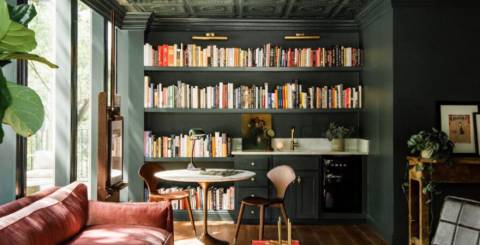12 Easy Ways to Design Your Room

Designing a room from scratch can be intimidating for the uninitiated, whether you don't have the budget to hire an interior designer or simply enjoy the idea of doing it yourself. Remember that room design is more of an art than a science, and there are no hard and fast rules for decorating a room. If you need a road map, this step-by-step guide will help you visualize all of the steps required to design your space like a pro.
1. Set the Mood
Instead of asking yourself how you want your space to look, ask yourself how you want it to feel, and let that guide your color, texture, furniture, and décor choices. A light and airy zen oasis might suggest natural materials and minimal furniture. Bold colors and patterns can be used to create an energizing, casual family space. Focusing on mood rather than style or trend will assist you in creating an eclectic space that works for you.
2. Get Inspired
For ideas, browse your favorite social media channels, interior design magazines, books, and websites. Consider the places you like to escape to and why. Make a mood board if that's what you're into. If you live alone, this is an opportunity to get to know yourself better. If you live with others, this is an opportunity to work together to create a shared space that honors everyone in the home.
3. Get Real
Rather than striving for some idealized vision of how your life should be, design your space for the way you live now. If you have boisterous children or pets, choose upholstery fabrics and surfaces that can withstand a beating while still looking great. There's no need to take up floor space with a dining table for six if you live alone and rarely entertain. If you work from home, relocate your makeshift office in the living room corner to the spare room that is only used during the holidays. And, before you buy anything, create a realistic budget to help you prioritize your spending along the way.
4. Declutter
Start by getting rid of anything you don't use, need, or love when redecorating. If you're starting from scratch, think before you bring anything in. Personal items and important items have a place in any space, but successful interior design begins with embracing the essentials and building from there.
5. Map It Out
If you want to create a floor plan, there are plenty of free online room design tools and home design software options available, but space planning doesn't have to be overly technical. To get a sense of scale and flow, sketch out layout ideas on paper or mark out furniture placement with painter's tape. Measure your space before purchasing any furniture. Take two measurements. Otherwise, the sofa you ordered may be too large to fit through your front door or too small for your living room.
6. Decide on a Color Palette
Whether you want to keep it neutral or have your heart set on a vibrant color palette, making a decision early on will help you create a unified look. Neutral rooms can be brightened with easily interchangeable accessories. If you've decided to make your room an ode to green, pink, or blue, choose three complementary colors to keep things interesting. If you like the look of an all-white room, sticking to white shades allows you to easily mix and match furniture styles and periods.
7. Start With the Finishes
If you want to do a makeover rather than a remodel, consider how you can use the existing flooring, wall color, and fixtures to beautify and personalize the space without having to renovate. Before bringing in furniture and accessories, refinish floors, paint walls, add tile, wallpaper, or wall panels, or install cabinetry if you're starting with an empty room.
8. Choose Anchor Pieces
Focus on your anchor piece, which is usually the sofa, before fussing over throw pillows when designing a living room. Making your most expensive purchases first will help ensure that you don't skimp on quality for high-use items, keep a realistic sense of your budget, and visualize how much room you have for additional furniture once the core pieces are installed.
9. Select Secondary Furniture
Once you've found the perfect sofa, start looking at coffee tables to see what sizes and styles work best, or whether an oversized pouf would be better. In the dining room, contrast with contemporary metal chairs if you chose a rustic wooden farm table. Vintage lighting or bedside tables can be used to complement a modern upholstered headboard.
10. Choose Rugs, Curtains, and Textiles
You can now choose rugs, curtains, and textiles such as bedding, throws, and decorative pillows that will complement your anchor pieces and add color, pattern, texture, and interest.
11. Light It Up
Paying attention to lighting is one of the keys to a successful room design. Maximize natural light during the day and layer in plenty of options for the evening, from functional task lighting to warm ambient table lamps or sconces to sculptural pendant lighting that doubles as décor. To avoid shadows and promote a sense of well-being after dark, make sure to light all four corners of the room.
12. Accessorize
Now that you've gathered all of the necessities, take a step back and consider what's missing. Choose and display art, photographs, or decorative mirrors. Add more decorative pillows and throws to the mix. Design books, candles, decorative objects, plants, or valuable souvenirs can be displayed on style shelves and tables. This is your opportunity to add texture to the room with personal touches that will bring it to life and make it feel like home.
Similar Articles
When it comes to transforming your home, few projects offer as much impact as a kitchen remodel or bathroom renovation. For homeowners, both of these areas can benefit significantly from a professional touch.
AS 1684 is vital for ensuring the safety, stability, and compliance of timber-framed buildings in Australia. However, many professionals make mistakes when applying this standard, which can compromise the quality and integrity of a project.
When people think about insulation, they often associate it with keeping homes warm in the winter and cool in the summer. While temperature regulation is one of its primary functions, insulation offers a range of additional benefits that many homeowners overlook
Boost home energy efficiency with top renovation tips—insulation, smart appliances, HVAC upgrades & more. Save money & reduce environmental impact!
Have you ever looked up at your roof and wondered if it’s still in tip-top shape? Are you asking yourself whether those small cracks or worn-out tiles could lead to bigger problems down the line? If so, you’ve come to the right place.
Smart home remodel tips: splurge on countertops & flooring, save on decor & lighting. Balance budget & luxury for a stylish, functional space!
Discover the rising trend of roller shades in modern homes! Essential window coverings for a sleek, stylish look. Transform your space now!
Transform your outdoor space with stone veneer! Discover benefits, installation tips, maintenance, and creative ideas for enhancing curb appeal and durability.
Marble is a luxury and high-end material that imparts a sense of timelessness to any living space. From a white Carrara marble table to an intricately veined dark marble surface, its elegance and sophistication make it an incredible focal point in your living space.









